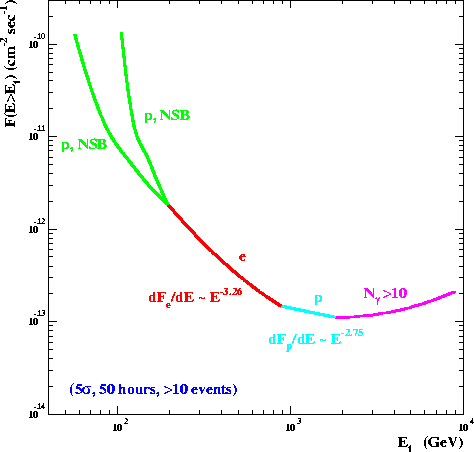The performance of VERITAS is summarized by its flux sensitivity
versus energy. The minimum detectable flux of gamma-rays is
defined by the confidence level required for detection or the
statistics of the detected photons. We require a 5![]() excess of
gamma-rays above the background, or 10 photons (below this, Poisson
statistics must be used). We estimate the flux sensitivity for 50
hours of observations on an object with a spectrum given by
dN/dE
excess of
gamma-rays above the background, or 10 photons (below this, Poisson
statistics must be used). We estimate the flux sensitivity for 50
hours of observations on an object with a spectrum given by
dN/dE![]() E-2.5, as seen from the Crab Nebula in this
energy range. We apply direction and image shape cuts to reject
background events.
E-2.5, as seen from the Crab Nebula in this
energy range. We apply direction and image shape cuts to reject
background events.
 |
The gamma-ray flux sensitivity of VERITAS for point sources as a
function of array energy threshold is shown in Figure 18.
The complex shape of the sensitivity curve is caused by different
energy regions being dominated by the different backgrounds shown in
Figure 18. For energies above 2 - 3TeV, the
sensitivity of VERITAS is limited by photon statistics. Larger
telescope fields of view can improve this sensitivity in the future,
as can large zenith angle observations. In the region near 1TeV,
the sensitivity is limited by those rare cosmic-ray protons which
mimic gamma-rays by converting most of their energy into an
electromagnetic cascade in the first few interactions (prompt decay of
![]() ). In the energy region between 200GeV and
). In the energy region between 200GeV and ![]() 1TeV, the
background rejection of VERITAS is so good that diffuse cosmic-ray
electrons are the dominant background instead of hadronic cosmic rays.
The region below 200GeV is limited by hadronic cosmic-ray events
whose reconstruction is significantly affected by small fluctuations
in the NSB. The more sensitive of the two curves indicates a
relatively dark observation region (like an AGN with no bright stars
in the FoV) while the less sensitive curve indicates a region where
the NSB light is approximately 4 times brighter (as in some regions of
the Galactic plane).
1TeV, the
background rejection of VERITAS is so good that diffuse cosmic-ray
electrons are the dominant background instead of hadronic cosmic rays.
The region below 200GeV is limited by hadronic cosmic-ray events
whose reconstruction is significantly affected by small fluctuations
in the NSB. The more sensitive of the two curves indicates a
relatively dark observation region (like an AGN with no bright stars
in the FoV) while the less sensitive curve indicates a region where
the NSB light is approximately 4 times brighter (as in some regions of
the Galactic plane).